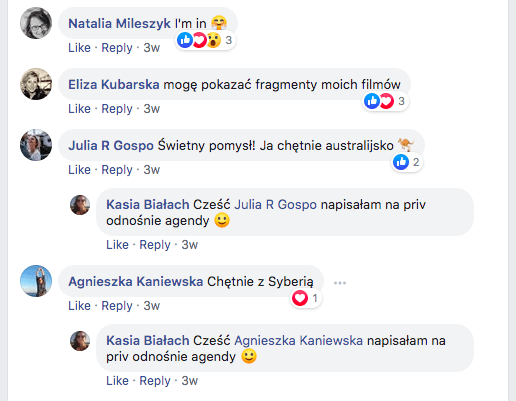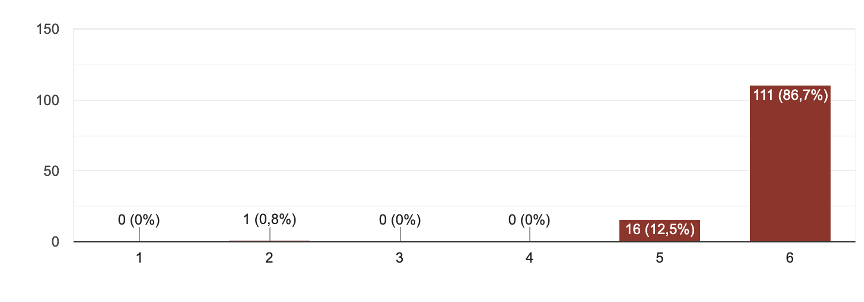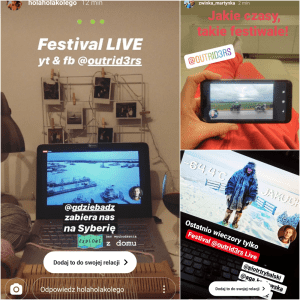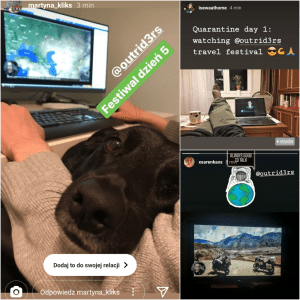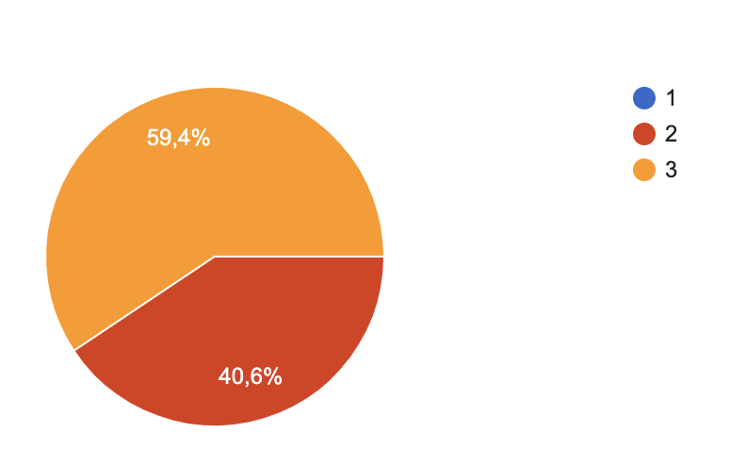How Outride.rs created an online festival and attracted 40k viewers!
Preset #1
You are reading this case study about Outride.rs on Outriders Mixer – so to avoid confusion here is little explanation. Those are sister projects. Outride.rs is our publication. The Mixer is where we share our know-how and also our work for other creators by providing tools, consultations, events, and so on. There has to be a more sharing culture in journalism!
What happened?
As coronavirus spread around Europe, before WHO called it a pandemic, Poland started social distancing and then going into lockdown and shutdown. For our team behind Outride.rs, which is covering global issues with local impact – there has never been a moment like this: when our mission statement has been fully understood by the audience. Regularly, we produce interactive stories, release a magazine sent via email to over 30k newsletter subscribers and extensively use technology to create stories.
But even though the organisation is fully remote and uses a cross-border approach to story production – we don’t do one thing – the news. And the coronavirus coverage is very news centric, occupying the attention of readers. More prominent outlets with their much bigger capacity are unbeatable by a startup.
Among all of this as Outride.rs we were preparing for a launch of our membership model which was primarily centred around two things: the Festiwal which was supposed to be held on June 27th 2020 and the full-scale event aimed for 2021 and second – cooperations with other companies offering benefits for the members. Both foundations were basically “postponed” till further notice.
That created three problems:
How to serve the audience now
How (and if) to redefine the membership value proposal
How to serve the audience long term – taking into consideration post-COVID19 reality
In this case study, we will focus on point one and half of point 2 – so taking the Festiwal part of the offering online.
First reaction
Usually, this part of the case study would be called “first step” or “the beginning” – but this was not a normal situation. Months of work and planning had to be dumped, frustration swallowed, and energy refocused towards finding solutions.
It’s important to note that Outride.rs had already been organising events in the past – both big and medium in scale. Given the high engagement they create among the community, this is why we decided to put it in the centre of the membership programme. All events were also live-streamed – so the know-how was present within the organisation, but an online-first event has never been developed by the team.
So it all started on March 12th when Anna Górnicka, our editor-in-chief wrote in the closed Facebook group: “We feel that in these times of mass pandemic reporting, something positive must be done.” And then she added that we want to make a live festival about the world. Members’ reaction was ultra-positive, so we posted this on public channels.
On October 6, 2019, US President Donald Trump announced that US troops would withdraw from Northern Syria. Three days later, on October 9, Turkey launched an offensive called “Operation Peace Spring” on the Turkish-Syrian border aiming to expel from its border the Syrian Kurdish militia called People’s Protection Units (YPG) and establishing a “safe zone” to resettle some refugees. US troops had relied on the Kurds to defeat ISIS. However, Turkey considers YPG a terrorist group due to its ties with the Kurdistan Workers Party (PKK). Turkey’s inclusion displaced 300,000 people and killed over 100 civilians, according to the Syrian Observatory for Human Rights, a UK-based organization.
Within a few hours, over 20 speakers (travellers, reporters, influencers) volunteered to speak, almost 1000 people signed up on Facebook. And the first edition was born within seven days. From March 19th five evenings in a row, starting at 9 pm, an online meeting was held for 2 hours. That edition was called “A window to the world” – as it operated on a straightforward emotional tone – we are all stuck at home, so let us bring a piece of the world to you. Our speakers were talking simply about their travels and exploration – they shared their stories. And the event was broadcasted publically.
Before March 19th, we also organised a surprise stream where two reporters talked about the current situation in Ukraine. It was a “final test before a test” – allowing to test all the equipment and setup.
When the test edition was concluded on 24th – seeing the first results and feedback, we decided to continue and take this “rapid action fueled by community” and turn it into a thing.
The Festiwal is born
Five days allowed the team to gather a lot of data, observations, and what’s most important – the community feedback. The audience was asked a simple question “how do you like the idea of the online festival (1 to 6 (6 is the highest mark))” and you can see such results you know you are onto something:
But here comes the hard part – everybody is streaming these days. Celebrities, dentists, dogs and cats – so that space is heavily occupied although creating a rare opportunity – to show that live stream is not just a poor clone of a regular event but it can be an experience too. And we wanted to be consistent with their brand promise – multimedia, high quality, in-depth approach to a topic. But also refreshing and cool.
So here it is what we did for the proper edition:
We shortened it to two nights and the time of start was 8 pm, not 9 pm (you don’t want to give people a chance to start their Netflix show ;). Moreover, most of the people are at home anyhow so standard rules “after work” don’t apply.
Days of the stream were narrowed down to Thursday and Friday (that comes from streaming engagement data).
A proper “theme” was introduced – so all presentations somehow touched the same topic and curation was done by the team not community-sourced. It featured – academics, reporters, influencers and travellers. The theme was “Home”, and Outride.rs wanted to allow the community to think about home as not only as walls and ceiling but to bring stories from around the world.
The community was asked to send their photos, videos and thoughts on what “Home” is via Whatsapp.
Format of the presentation was changed from 30 mins + QA to two – 18-minute presentations followed by Q&A with the community and 5-7 minute shorter videos.
The presentation was live, and the videos were submitted before by selected people.
It allowed creating a better experience as while the videos were broadcasted the tech team could “swap” speakers before they went live during the test edition that happened all live. As funny as it could sometimes be it was tiring after some time for viewers.
Additionally, more speakers could be brought in thanks to short videos, creating a more dynamic narrative and they featured authors from Australia, Iceland or Polish mountains (where the Internet is slow, and the upload takes ages).
An after party was introduced – but not on the streaming platforms used for the Festiwal – but on Instagram Live. The host (me 😉 ) closed down the Festiwal day and invited others for an additional 30 minutes of a very casual conversation.
A considerable improvement was made towards the technological equipment. The test edition took seven days to organise. With pandemic conditions, not all deliveries were made on time, and not all needs were known. Special tools for production and remote control of presentations for speakers were added.
Also, we added a teaser + dedicated opener and dedicated branding playing with the idea of “Home.”
So in the end Outriders Festiwal took place during two nights – April 2nd and 3rd. We broadcasted online primarily on YouTube Live and Facebook Live. It featured 15 speakers from all around the world showing presentations themed “Home”.
It was opened by professor Jerzy Bralczyk – a famous Polish linguist – discussing the meaning of the word “home”. But he didn’t have a video connection – he called in via landline. So… we asked one of the illustrators to Skype in from her iPad Pro, to create a bridge from the phone to her with tons of cables so in the end while the speaker was talking he was being illustrated live. With the upgraded approach, tech and frankly some prayers that presentation smoothly opened up the whole Festiwal making a wow effect.
Festiwal continues to create an emotional experience for the audience. When we asked them to show where they watched us – those photos we received.
Results, numbers and impact
So let’s see what those crazy days gave us in numbers.
1078 registered via email for test and the first edition (and we did f*** up the initial registration process when we announced it went viral and only later we added proper registrations forms and websites).
40k+ viewers started watching the stream.
Combined with our previous events we launched an ad-hoc newsletter only for such activities which now has 2634 subscribers.
We asked people to show on their Instagram stories where they watched us – we received over 50 photos.
Some social numbers:
To give you an idea of how social it was – we primarily focus on Instagram and email. Even though we have a Facebook page with over 45k followers, it’s not very active. In past days though:
We reached 192,460 people – 249% of norm.
Post engagements 41,760 – 895% growth (sic!).
The new page likes 906 – 372% growth!
YouTube – 706 news subscribers (2372 in total), so 50% growth here.
From community surveys:
What do you think about the quality of presentations?
What do you think about the tech quality?
What device did you use to watch our Festiwal – 23,4% watched it on their TVs!
How many presentations should there be per day?
How much time should be dedicated for audience’s questions to speakers?
Challenges
Everything in this particular case study relates to coronavirus. The rapid change of approach, redefining models, being home with kids for some of our Outride.rs team… It was not easy and physically as demanding as a normal event. Our team was at homes – we couldn’t do it from one location (though we don’t have an office we could at least meet)
But to name a few which can be useful of others:
The biggest challenge was to get necessary equipment in the times of quarantine where deliveries are slower, and the whole world decided to start streaming effectively buying out most of the gear needed. All our regular events were usually live-streamed – usually by a professional crew.
The same person did production and hosting the event – that should be disconnected, but the quarantine does impose certain restrictions.
A new way of presenting for speakers – many of them are used to being on the stage and to use their whole body expression. Whereas in this case, they were just hiding in the corner of the screen.
Lessons
A lot of lessons were already named between test and “Home” editions, but there are few more generic:
You are as good as your weakest link – so don’t go crazy on doing everything 4k – if your speaker is calling in from a remote location and has a very slow Internet connection the contrast will be very high.
The shitty story is still shitty in 4k – remember to focus on curation, talking to speakers, doing test broadcasts, rehearsal – everything you would do on a regular event.
Audio is critical – the audience will survive 360p video quality, but they won’t stay if they can’t hear you well.
Test! – we organised a test edition and asked our community to help. Over 20 people volunteered with presentations. Every day we also used a different format which received immediate feedback in comments as viewers were noticing immediate differences.
Don’t go for TV standards – one day we “reduced” our host to focus on maximum quality and we lost that “sense” of “our ” Festiwal. So don’t be shy to show you are broadcasting from your bedroom.
Put the camera on the height of your eyes. So put some books below your laptop or mini tripod to mount an external webcam. That’s it – you don’t have to go to the new Sony mirrorless.
Go digital and free yourself from constraints of regular/traditional events – they are different and shaped mainly by travel and all the logistics. This is why we think of them in “days”. One day, two days…. In digital – think in hours, time of a day, and so on. In the same way – it’s so easy to “fly in” those amazing speakers from other continents you never had enough budget for.
To reiterate the point above – don’t transfer your event to digital 1:1. Transfer it’s the essence but adapt to the new reality.
It was not built in normal times – so you don’t have to pretend you have everything figured out. Include your community in that process and be transparent.
Technical break emergency screen 😉
Technology we used
And here we come to the part where we geek out but since Outride.rs rely so much on technology – we can forgive it. Plus the author of this case study was both host and producer, so he now needs some space to show off 🙂
Our demands were – to provide maximum high quality for multimedia presentations, give people the ability to comment and talk to our guests and create something enjoyable.
Let’s start with hardware as it explains the software we used.
Two laptops
One was used to producing, streaming and taking calls via Skype. Second one was only doing presentations. Speakers were remotely controlling that laptop to save their bandwidth since they had videos and multimedia that allowed us to broadcast with maximum quality.
Tablet / mobile phone – to monitor the quality of the output.
Elgato Stream Deck – it’s a magic keypad where you assign predefined scenes, e.g. “show speaker”, “show speaker’s presentation, “show intro” etc.
Zoom H6 – for audio of the host.
Logitech Brio – not for the 4k quality it offers, but better cropping and lighting.
Bunch of cables – we had one situation where the speaker was calling in via GSM connections. That phone was connected through USB-C splitter to Zoom H6.
Headphones – to hear production.
We asked speakers to use timers to time themself on their own – so they primarily used their phones.
Mobile internet – all the devices which were used to monitor the stream were not connected to the main wifi – we used separate mobile internet.
Software we used
Ecamm Live – the heart of the operation – this is our production software
Skype – even though I didn’t use Skype for ages, it has one crucial feature – NDI, which allows other apps to access different video feeds. Each person calling you becomes a video source in Ecamm Live + if they share a screen that’s also separate. Skype can also share a screen from an iPad which we used in one particular instance.
Restream.io – thanks to this we streamed simultaneously to YouTube Live, Facebook Page, Twitter/Periscope and Twitch.
Restream Chat – this is part of Restream Pro package – special software that allows you to manage in one place comments from all platforms you stream to. So e.g. if you want to inspire viewers to post.
TeamViewer – speakers were accessing our 2nd laptop and controlling the presentation remotely
Google Slides – backup for presentations.
Google Slides Remote – that’s a third party hack allowing people to control their slides remotely. It is very handy if you don’t have a second laptop. Sometimes a bit unstable, but if you rehearse with speakers, it should go smooth.
So what is the future?
We feel we have a product now. It’s different then what we planned a few months ago – but now with technology and overall flow mastered we no longer think about it. We built landing pages, websites, and invested in technology and branding. But most of all – we created demand, interest and proved to the community that this could work.
We are now focused on how to take this to another level. The next edition is coming live on April 28th 2020.
Online events create many new opportunities. We can bring any speaker we want much cheaper; we can play with forms and formats in our digital channels. They are also more planet-friendly.
Will we abandon traditional events? We don’t think so – but our strategy will for sure never be the same and decisions which event to host in a traditional way and which to host digitally will now be made without thinking that online events are no longer serious.



